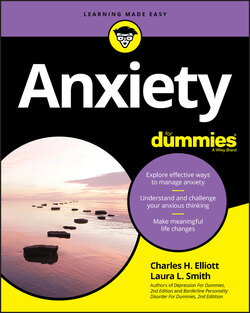Читать книгу Anxiety For Dummies - W. Doyle Gentry, Laura L. Smith - Страница 8
ОглавлениеIntroduction
We wrote our first book in the For Dummies series, Overcoming Anxiety For Dummies, shortly after the events of 9-11-2001. People felt rather anxious, especially about terrorism. We wrote the second edition in 2010 as the Great Recession was winding down. At that time, people were feeling particularly anxious about their finances and careers. Today, we present Anxiety For Dummies as the world struggles to cope with a global pandemic, an explosion of civil unrest and racism, climate change, and another potentially massive recession or depression.
So today’s world, just like the previous two decades, gives us plenty to worry about. But as we don’t want to become victims of a pandemic, financial setback, natural disaster, or violence, we can’t let ourselves become victims of anxiety. Anxiety clouds our thinking and weakens our resolve to live life to the fullest. We realize that some anxiety is realistic and inescapable, yet, we can keep it from dominating our lives. Even under duress, we can preserve a degree of serenity; we can hold onto our humanity, vigor, and zest for life. We can love and laugh.
Because we believe in our collective resilience, we take a humorous, and at times irreverent, approach to conquering anxiety. Our message is based on sound, scientifically proven methods. But we don’t bore you with the scientific details. Instead, we present a clear, rapid-fire set of strategies for beating back anxiety and winning the war against worry.
About This Book
We have three goals in writing this book. First, we want you to understand just what anxiety is and some of the different forms it can take. Second, we think that knowing what’s good about anxiety and what’s bad about it is useful for you. Finally, we cover what you’re probably most interested in — discovering the latest techniques for overcoming your anxiety and helping someone you care about who has anxiety.
Unlike most books, you don’t have to start on page 1 and read straight through. Use the extensive table of contents to pick and choose what you want to read. Don’t worry about reading parts in any particular order. For example, if you really don’t want much information about the who, what, when, where, and why of anxiety and whether you have it, go ahead and skip Part 1. However, we encourage you to at least skim Part 1, because it contains fascinating facts and information as well as ideas for getting started.
Scattered throughout this book are case examples and stories that illustrate important principles and techniques. Although these examples are based on composites of real people, they do not represent any actual person. Any similarities to actual cases or people are purely coincidental.
Foolish Assumptions
Who might pick up this book? We assume, probably foolishly, that you or someone you love suffers from some type of problem with anxiety or worry. But, it’s also possible that you simply find the topic of anxiety interesting. We imagine that you may be curious about a variety of helpful strategies to choose from that can fit your lifestyle and personality. Finally, you may be a mental health professional who’s interested in finding a friendly resource for your clients who suffer from anxiety or worry.
Icons Used in This Book
For Dummies books use little pictures, called icons, in the margins to get your attention. Here’s what they mean:
The Remember icon appears when we want your attention. Please read the text associated with it for critical information.
The Tip icon alerts you to important insights, clarifications, or ways to do things better.
Warning icons appear when you need to be careful, avoid potential risks, or seek professional help.
The Technical Stuff icon highlights information that some readers will find interesting but is not necessary for your overall understanding of anxiety.
Beyond the Book
For quick tips about anxiety, go to www.dummies.com, and type “Anxiety For Dummies Cheat Sheet” in the search box. You can get information about how to identify anxious thoughts, behaviors, and feelings. In addition, there are some suggestions for dealing with your anxious symptoms.
Where to Go from Here
Anxiety For Dummies offers you the best, most up-to-date advice based on scientific research on anxiety disorders. If you want help controlling your negative thoughts, turn to Chapters 6 and 7. If you’re concerned about living well during a pandemic, check out Chapter 13. If you’re worried about your job and finances, in Chapter 14 we provide tips for finding your next job and pinching pennies. Chapter 16 is a new chapter about anxiety related to racism.
For some people, this book could be a complete guide to fighting frenzy and fear. However, some stubborn forms of anxiety need more care and attention. If your anxiety and worry significantly get in the way of work or play, get help. Start with your family doctor to rule out physical causes. Then, consult with a mental health professional. Anxiety can be conquered, so don’t give up.
